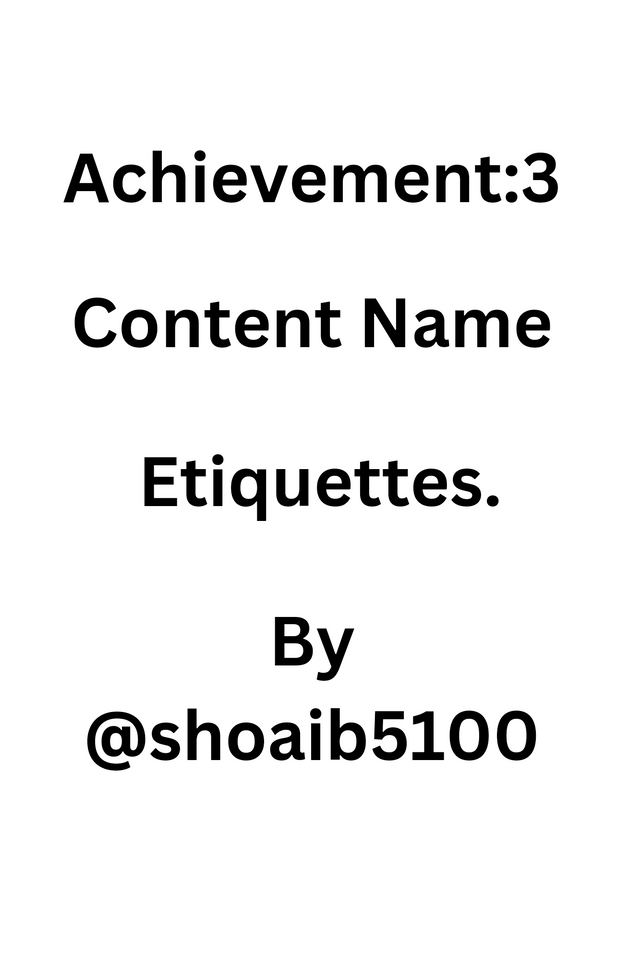
To all steemit members I hope all of you will be fine and working doing well.I am also fine with the blessing of Allah Almighty.I'm moving towards my Achievement 3 on Content Etiquettes.
What is plagiarism?
The use of another person's words or ideas without their consent or due credit is known as plagiarism. It can take many different forms, like verbatim copying, paraphrasing without giving credit, or utilizing brief passages from another person's work without giving due credit. Plagiarism is regarded as unethical and is punishable by law, loss of reputation, and academic sanctions, among other dire outcomes. To prevent plagiarism, it's critical to constantly provide due credit and cite sources correctly.
Types of Plagiarism:
1. Direct Plagiarism.
- Copying verbatim, without acknowledgment, from a source is known as direct plagiarism. It entails using someone else's words, phrases, or full paper and passing it off as one's own without giving credit to the original creator.
- In academic or professional settings, direct plagiarism is typically not accepted as it is regarded as a serious kind of plagiarism.
2. Self-Plagiarism
- Reusing one's own previously published work without giving due credit or permission is known as self-plagiarism. It can take many different forms, including turning in the same paper or sections of it to several classes or sending the same article to several journals without giving credit where credit is due.
- Since self-plagiarism has the potential to deceive readers and compromise the credibility of publications and academic processes, it is typically seen as unethical.
3. Mosaic Plagiarism
- Mosaic plagiarism is a type of plagiarism in which a writer borrows brief passages from different sources and incorporates them into a new piece without giving due credit to the original authors.
- Because mosaic plagiarism can happen accidentally—particularly if the writer is unfamiliar with correct citation techniques or does not fully comprehend the notion of paraphrasing—it is also known as "patchwork plagiarism" or "accidental plagiarism."
4. Accidental Plagiarism
- Accidental plagiarism refers to the unintentional use of someone else's work or ideas without proper attribution. It can happen when a person is not familiar with proper citation methods, forgets to cite a source, or mistakenly believes that the information is common knowledge and does not require citation.
- While accidental plagiarism may not be intentional, it is still considered a form of plagiarism and can have serious consequences, such as reduced grades or damage to one's reputation. To avoid accidental plagiarism, it is important to always cite sources and use proper citation methods.
5. Paraphrasing Plagiarism
- Paraphrasing plagiarism occurs when a person rewords someone else's work or ideas without proper attribution. It involves taking the original text and rephrasing it in one's own words, but without giving credit to the original author.
- While paraphrasing is a common technique used in research and writing, it is important to always properly cite the original source to avoid plagiarism. Failure to do so can result in accusations of paraphrasing plagiarism, which can have serious consequences, particularly in academic or professional settings.
How to avoid plagiarism:
- To avoid theft, we need to enter our content .
- Theft can also be avoided by referring to any content we pick up so that we can avoid theft.
- You should know that it is actually called theft.
Consequences of plagiarism
A student facing plagiarism charges may face expulsion from the school and have their academic record reflect their moral guilt. Universities and colleges take theft very seriously.
Citation:
The purpose of the reference is to highlight the connection between the author and the material, making it simpler for the reader to conduct additional research and letting them know when a portion of your writing is not original to you.
How to cite a text.
Finding any text is as simple as going to Google and entering in the author's name and address to learn more about any text you are looking for. You can also ask me to download it if you'd like.
Conclusion:
I have thoroughly read about Steemit plagiarism and am well-informed about it. I will now write everything I know about Steemit plagiarism in communities. What are the drawbacks of plagiarism, and I did my best to explain the rest based on what I know Will.


Hi I hope you are well, after reviewing your achievement 3 i must inform you that this does not meet the requirements established for validation according to the Newcomers' Community.
“You must use one of the citation examples described in the explanation of achievement 3, For this you must make a post of no less than 200 words of your authorship about what plagiarism is and additionally include the aforementioned examples (they will not be counted within 200 words)”.
“All the content used that is not 100% of your authorship must be cited according to what is described in the protocol of achievement 3”.
Make the corrections and I will come back to verify your achievement
Greetings
Downvoting a post can decrease pending rewards and make it less visible. Common reasons:
Submit